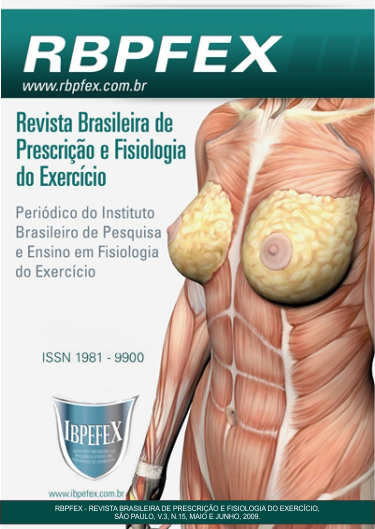Behavior of the arterial pressure and of the cardiac frequency in a lesson using the Pilates method
Abstract
Practical of exercises resisted is being recommended as form to improve the health, being the accompaniment of the systolic and diastolic arterial pressure (SAP and DAP) and of the cardiac frequency (HR) important to if prescribing this type of exercise. The Pilates method considers physical conditioning for force profit, flexibility and corporal conscience. 12 females volunteers, normotensive, not smoking, sedentary and without health problems that intervened with the execution of the exercises, had participated of the study. All had carried through one hour of lesson of Pilates. The AP was surveyed through the auscultation method and the HR was measured through the cardio-tachometer. The data had been surveyed in the rest, during the lesson and 30 minutes after its ending. The systolic arterial pressure after presented rise during the lesson of up to 140 mmHg. the lesson, had varied behaviors. The DAP also presented varied values, having in some cases occurred rise for 90 mmHg. The HR did not exceed 95 bpm. During the exercises, the HR would not have to exceed 133 bpm (70% of the maxi HR) what, in fact, it occurred. The different answers of SAP can have explanation in the different positions of the volunteers during the circuit. The SAP, after 30 min of the ending of the lesson, presented values that they corroborate with the previous studies, where has controversies on the results. The behavior of the DAP can have explanation in the use of accessory musculature on the part of the volunteers. We conclude that the results show values of the normal standards inside, however, other studies must be carried through so that the results have trustworther character.
References
- Aires, M.M. Fisiologia. Rio de Janeiro. Guanabara Koogan. 1991. p. 405-411;422-433.
- Araújo, C.G.S. Fisiologia do exercício físico e hipertensão arterial: uma breve introdução. Hipertensão. vol. 4. num. 3. 2001. p. 78-83.
- Bermudes, A.M.L.M.; Vassallo, D.V.; Vasquez. E.C.; Lima, E.G. Monitorização ambulatorial da pressão arterial em indivíduos normotensos submetidos a duas sessões únicas de exercícios: resistido e aeróbio. Arquivo Brasileiro de Cardiologia. vol. 82. num. 1. 2003. p. 57-64.
- Carter, J.R.; Ray, C.A.; Downs, E.M.; Cooke, W.H. Strength training reduces arterial blood pressure but not sympathetic neural activity in young normotensive subjects. J Appl Phisiol. vol.94. 2003. p.2212-2216.
- Dillman, K. O pequeno livro de Pilates: guia prático que dispensa professores e equipamentos. Rio de Janeiro. Record. 2004. p. 41-54.
- Forjaz, C.L.M.; Rezk, C.C.; Melo, C.M.; Santos, D.A.; Teixeira, L.; Nery, S.S.; Tinucci, T. Exercício resistido para o paciente hipertenso: indicação ou contra indicação. Revista Brasileira de Hipertensão. vol.10. num. 2. 2003. p. 119-124.
- Kolyniak, I.E.G.G.; Cavalvanti, S.M.B.; Aoki, M.S. Avaliação isocinética da musculatura envolvida na flexão e extensão do tronco:efeito do método Pilates. Revista Brasileira de Medicina do Esporte. vol. 10. num. 6. 2004. p. 487-490.
- Lamonde, P. Pilates: Controle Harmonioso do Corpo. Lisboa. Estampa. 2003. p. 10-13.
- Leite, T.C.; Farinatti, P.T.V. Estudo da freqüência cardíaca, pressão arterial e duplo produto em exercícios resistidos diversos para grupamentos musculares semelhantes. Revista Brasileira de Fisiologia do Exercício. vol. 2. 2003. p. 29-49.
- McArdle, W.D.; Katch, F.I.; Katch, V.L. Fisiologia do Exercício: energia, nutrição e desempenho humano. 4.ed. São Paulo. Guanabara Koogan.1998. p. 255-281.
- Miranda, H.; Simão, R.; Lemos, A.; Dantas, B.H.A.; Baptista, L.A.; Novaes, J. Análise da freqüência cardíaca, pressão arterial e duplo –produto em diferentes posições corporais nos exercícios resistidos. Revista Brasileira de Medicina do Esporte. vol. 11.num. 5. 2005. p. 295-298.
- Polito, M.D.; Simão, R.; Senna, G.W.; Farinatti, P.T.V. Efeito hipotensivo do exercício de força realizado em intensidades diferentes e mesmo volume de trabalho. Revista Brasileira de Medicina do Esporte. vol. 9. num. 2. 2003. p. 69-73.
- Polito, M.D.; Rosa, C.C.; Schardong, P. Respostas cardiovasculares agudas na extensão do joelho realizada em diferentes formas de execução. Revista Brasileira de Medicina do Esporte. vol. 10. num. 3. 2004. p. 173-176.
- Robergs, R.A.; Roberts, S.O. Princípios fundamentais de Fisiologia do Exercício para Aptidão, Desempenho e saúde. 1.ed. Phorte. 2002. p. 144-163;250-264.
- Simão, R.; Fleck, S.J.; Polito, M. Monteiro, W.; Farinatti, P. Effects of resistance training intensity, volume, and session format on the posterxercise hipotensive response. Journal of Strenght an Conditioning Research. vol. 19. num. 4. 2005. p. 853-858.
- Ungaro, A. Pilates Body in Motion. London.Dorling Kindersley. 2002. p. 9-23.
Authors who publish in this journal agree to the following terms:
- Authors retain the copyright and grant the journal the right of first publication, with work simultaneously licensed under the Creative Commons Attribution License BY-NC which allows the sharing of the work with acknowledgment of the authorship of the work and initial publication in this journal.
- Authors are authorized to enter into additional contracts separately for non-exclusive distribution of the version of the work published in this journal (eg, publishing in institutional repository or book chapter), with acknowledgment of authorship and initial publication in this journal.
- Authors are allowed and encouraged to post and distribute their work online (eg, in institutional repositories or on their personal page) at any point before or during the editorial process, as this can bring about productive change as well as increase impact and impact. citation of published work (See The Effect of Free Access).






